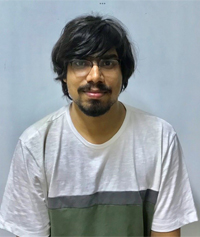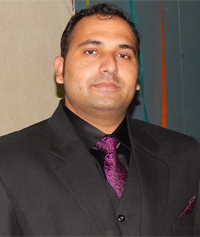Faculty
Prof. Animangsu Ghatak
Professor,
Department of Chemical Engineering
Specialization
Mechanics of soft materials, Adhesion, friction and fracture at soft interfaces, Locomotion of soft bodied objects, Fracture of soft gels, Membraneless fuel cell, Design of universal nucleant for crystallization of protein molecules.
PhD Students

I am currently working under Prof Animangsu Ghatak for my doctoral thesis. My research interests are in the general area of complex emulsion, wettability of surfaces by complex liquid, adhesion on rough surfaces, elasto-capillary effect and interfacial reaction at soft-solid/liquid interfaces. I have developed a process for large area, nano-to-microscopic hierarchical patterning of soft surfaces. I have used these surfaces for understanding the effect of random roughness of substrate on particle adhesion. My research has led to the development of a reusable and washable adhesive, a rewritable and reprintable paper surface and an antibacterial sticky pad.
Publications
- Singh, N., Ghatak, A., Hierarchically Rough Surface used as Rewritable and Reprintable paper, arXiv preprint arXiv:2111.12430.
- Singh, N., Jain, Y., Kishore, K., Ghatak, A. Liquid spreading induced by in-situ generation of metallic nano-particles, Langmuir 2020, Vol 36(41), pp 12237-12246.
- Maiti, S. Singh, N., Ghatak, A. Confinement induced alteration of morphologies of oil-water emulsion, Langmuir 2019, Vol 35(10), pp 3797-3804.

I am pursuing my Ph.D. in the Department of Chemical Engineering at IIT-Kanpur under the guidance of Prof. Animangsu Ghatak. Earlier, I received my B.Tech. in Chemical Engineering from Kurukshetra University in 2012 and M.E. in Chemical Engineering with Specialization in Petroleum from BITS-Pilani in 2015. I also worked in polymer industry for about a year as a graduate engineer trainee after my undergraduate studies.
My research is focused on designing a novel composite adhesive material that will be useful for diverse applications such as tissue adhesion, transdermal drug delivery patches, benign biomedical tapes, model human skin for cosmetic testing and applications related to flexible electronics and soft robotics. I have carried out extensive experimental work on design and characterization of this new kind of material that consist of a hydrogel phase dispersed in a continuous matrix of a silicone elastomeric phase. I have shown that this material can be useful for adhesion on dry and wet surfaces. I am working on optimization of surface and bulk properties of these materials
Publications
- 1. Kuhar, K., Jesbeer, M., Ghatak, A., Soft gel-filled composite adhesive for dry and wet adhesion, ACS Applied Polymer Materials. 2021. Vol 3(8), pp 3755-3765.

Presently I am pursuing PhD at IIT Kanpur under the guidance of Prof. Animangsu Ghatak. Prior to that, I received my M.Tech from University of Calcutta in 2018 and B.Tech from Heritage Institute of Technology, Kolkata in 2016.
My current research includes study of mechanical properties of self-healing properties of soft gels. Self-healing material's ability to self-repair any damage and regain its original properties has attracted significant attention in diverse fields like soft-robotics, flexible electronics, biomedical applications, surface coatings etc. Mimicking the self-healing phenomena of living organisms and biological tissues, synthetic self-healing materials such as hydrogel or silicone based elastomer like PDMS have been synthesized by researchers by incorporating reversible physical/ chemical bonds into their polymeric network. Inspired by these recent works, I am trying to make elastomeric materials which can self heal and examining the mechanical strength that a healed joint can achieve. I am examining also the ageing effect of the joint, self-healing efficiency over multiple cycles of fracture and healing and possible effects of the ambient condition like temperature and humidity on the strength of the joint. I intend to explore also practical applications of these self-healing elastomers.
